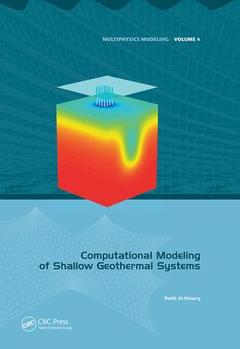Description
Computational Modeling of Shallow Geothermal Systems
Multiphysics Modeling Series
Author: Al-Khoury Rafid
Language: English
Subjects for Computational Modeling of Shallow Geothermal Systems:
Keywords
Borehole Heat Exchanger; borehole; Ground Heat Exchanger; heat; Shallow Geothermal Systems; exchanger; Ordinary Differential Equation; flow; Finite Difference Method; equation; OFA; flux; T1 T2; transfer; Vertical Borehole Heat Exchanger; conductivity; SEM; interaction; Laplace Transform; soil; Fourier Bessel Series; Ground Source Heat Pumps; Line Source Model; Surrounding Soil Mass; Local Volume Averaging; Thermal Interaction; Heat Equation; Spectral Element; Field Equation; Geothermal Heat Pumps; Local Thermal Non-equilibrium; Local Thermal Nonequilibrium; Heat Flow; Dx Dy Dz; Heat Pump
Publication date: 03-2017
· 17.4x24.6 cm · Paperback
Publication date: 09-2011
254 p. · 17.4x24.6 cm · Hardback
Description
/li>Contents
/li>Readership
/li>Biography
/li>
A Step-by-step Guide to Developing Innovative Computational Tools for Shallow Geothermal SystemsGeothermal heat is a viable source of energy and its environmental impact in terms of CO2 emissions is significantly lower than conventional fossil fuels. Shallow geothermal systems are increasingly utilized for heating and cooling of buildings and greenhouses. However, their utilization is inconsistent with the enormous amount of energy available underneath the surface of the earth. Projects of this nature are not getting the public support they deserve because of the uncertainties associated with them, and this can primarily be attributed to the lack of appropriate computational tools necessary to carry out effective designs and analyses. For this energy field to have a better competitive position in the renewable energy market, it is vital that engineers acquire computational tools, which are accurate, versatile and efficient. This book aims at attaining such tools.
This book addresses computational modeling of shallow geothermal systems in considerable detail, and provides researchers and developers in computational mechanics, geosciences, geology and geothermal engineering with the means to develop computational tools capable of modeling the complicated nature of heat flow in shallow geothermal systems in rather straightforward methodologies. Coupled conduction-convection models for heat flow in borehole heat exchangers and the surrounding soil mass are formulated and solved using analytical, semi-analytical and numerical methods. Background theories, enhanced by numerical examples, necessary for formulating the models and conducting the solutions are thoroughly addressed.
The book emphasizes two main aspects: mathematical modeling and computational procedures. In geothermics, both aspects are considerably challenging because of the involved geometry and physical processes. However, they are highly stimulating and inspiring. A good combination of mathematical modeling and computational procedures can greatly reduce the computational efforts. This book thoroughly treats this issue and introduces step-by-step methodologies for developing innovative computational models, which are both rigorous and computationally efficient.
Part I: PreliminariesChapter 1: Introduction
Chapter 2: Heat transfer
Chapter 3: Heat transfer in porous media
Chapter 4: Heat transfer in borehole heat exchangers
Chapter 5: Thermal resistance
Part II: Analytical and Semi-Analytical ModelingChapter 6: Eigenfunction expansions and Fourier transforms
Chapter 7: Laplace transforms
Chapter 8: Commonly used analytical models for ground-source heat pumps
Chapter 9: Spectral analysis of shallow geothermal systems
Chapter 10: Spectral element model for borehole heat exchangers
Part III: Numerical ModelingChapter 11: Finite element methods for conduction-convection problems
Chapter 12: Finite element modeling of shallow geothermal systems
Rafid Al-Khoury is a Senior researcher in computational mechanics in the Faculty of Civil Engineering and Geosciences at Delft University of Technology, The Netherlands. His main area of interest is in computational mechanics with emphasis on computational geoenvironment. In particular, he is a developer of analytical, semi-analytical and numerical models for wave propagation in layered systems, multiphase flow and heat and fluid flow in shallow geothermal systems. The main focus of his research work is the development of innovative models and efficient computational procedures capable of simulating physical processes occurring in complicated geometry using minimal computational efforts. Along this line, Dr. Al-Khoury has published several models for different fields of computational mechanics, including wave propagation, parameter identification, fracturing porous media, and geothermics.
These books may interest you

Geothermal Energy Systems 159.65 €



